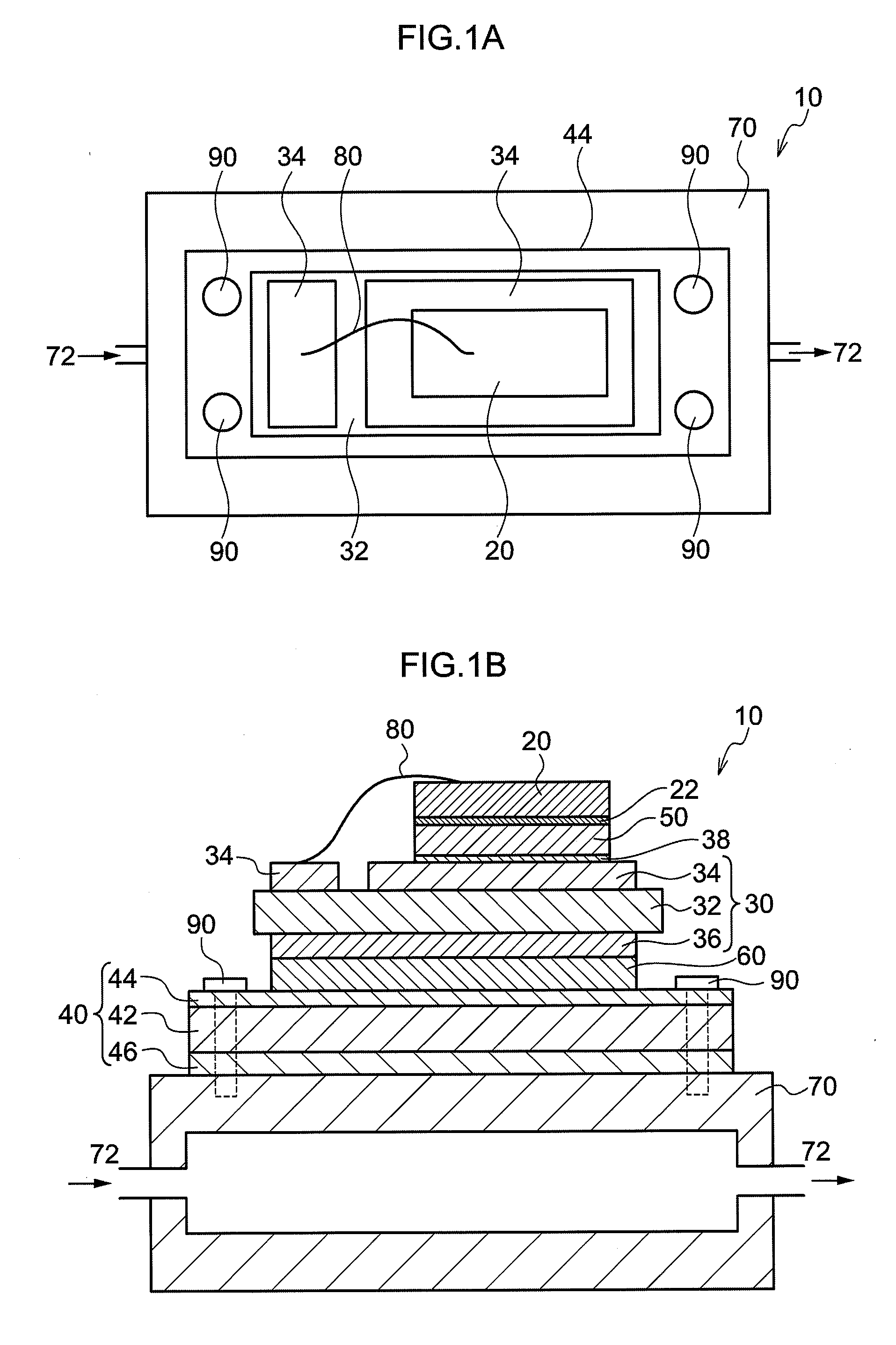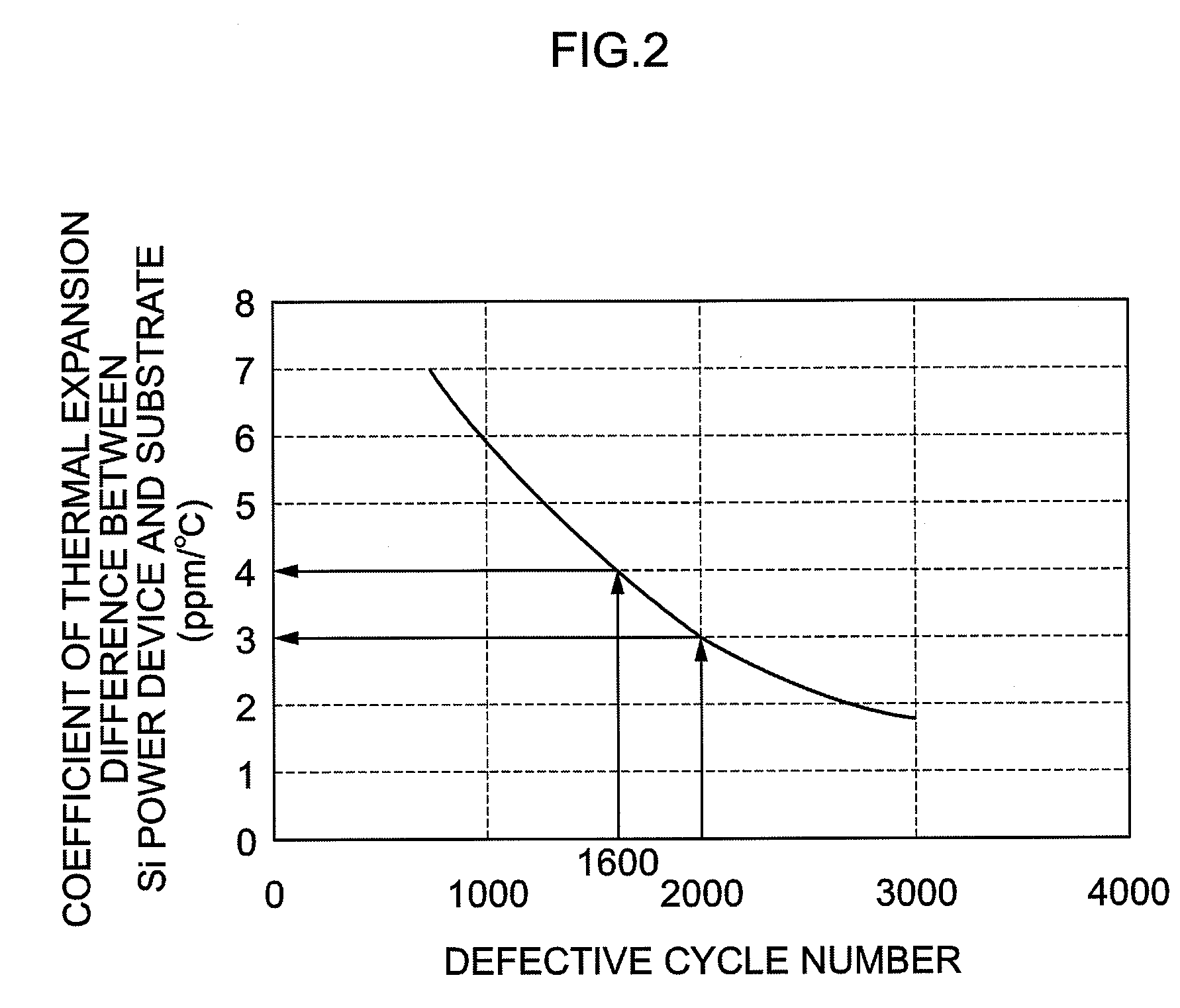Power semiconductor module
a technology of semiconductor modules and semiconductor components, applied in semiconductor devices, semiconductor/solid-state device details, electrical apparatus, etc., can solve the problems of increasing temperature, generating a large amount of heat, and generating power loss, and achieves high reliability power, sufficient life, and no thermal cycling of defects
- Summary
- Abstract
- Description
- Claims
- Application Information
AI Technical Summary
Benefits of technology
Problems solved by technology
Method used
Image
Examples
example 1
[0279]FIG. 1 shows the structure of a power semiconductor module of the present example.
[0280]
[0281]A power semiconductor element 20 was prepared in 12 mm×9 mm in size, by using SiC (coefficient of thermal expansion: 3 ppm / ° C.). A Ni layer 22 was formed on an outermost surface thereof by sputtering. An Au layer (not illustrated) was formed on the surface of the Ni layer 22 by sputtering.
[0282]
[0283]As an insulating part 30, a laminated body of a Cu layer 34 / SiNx layer 32 / Cu layer 36 was formed.
[0284]First, SiNx having 0.32 mm in thickness was prepared, and the Cu layers 34 and 36 having 0.05 mm in thickness were attached to both surfaces of this SiNx by brazing, so as to form a laminate-1.
[0285]Laminates-2, -3 and -4 were formed in the same manner, except that the thickness of the Cu layers 34 and 36 were changed to 0.1 mm, 0.15 mm or 0.3 mm, respectively. At the both surfaces of the SiNx, the thicknesses of the Cu layers were made equal to each other.
[0286]Insulating part laminate...
example 2
[0310]An evaluating test body-1 was produced, in which a power semiconductor element and an insulating part were bonded to each other by a Bi based solder material, as shown in FIG. 8.
[0311]
[0312]The power semiconductor element 20 was prepared in 12 mm×9 mm in size, by using SiC (coefficient of thermal expansion: 3 ppm / ° C.). A Cu layer 22 was formed on an outermost surface thereof by sputtering.
[0313]
[0314]The laminate-2 (the layer thickness of the Cu layer: 0.1 mm) of the insulating part in Example 1 was prepared.
[0315]
[0316]A pure Bi substance was cut into a thickness of 150 to 220 μm. An oxide film covering the surface of the cut pure Bi substance was removed by use of polishing and washing with an acid.
[0317]The Cu layer 22 of the power semiconductor element 20 prepared as described above and the Cu layer 34 of the insulating part 30 were arranged to be opposed to each other. In the state where the pure Bi substance layer was sandwiched therebetween, a reflow method in the atmo...
example 3
[0324]An evaluating test body-2 was produced in the same manner as in Example 2, except that the pure Bi substance as a bonding material was replaced by a material in which 1% by mass of Cu was added to Bi.
[0325]The resultant evaluating test body-2 was tested in the same thermal cycling test as in Example 2. As a result, a reaction product was not observed at the interfaces of the bonding sections. Neither voids nor cracks were recognized. Accordingly, it was verified that the evaluating test body-2 was highly reliable even through the thermal cyclings under the severe conditions.
PUM
 Login to View More
Login to View More Abstract
Description
Claims
Application Information
 Login to View More
Login to View More - R&D
- Intellectual Property
- Life Sciences
- Materials
- Tech Scout
- Unparalleled Data Quality
- Higher Quality Content
- 60% Fewer Hallucinations
Browse by: Latest US Patents, China's latest patents, Technical Efficacy Thesaurus, Application Domain, Technology Topic, Popular Technical Reports.
© 2025 PatSnap. All rights reserved.Legal|Privacy policy|Modern Slavery Act Transparency Statement|Sitemap|About US| Contact US: help@patsnap.com



